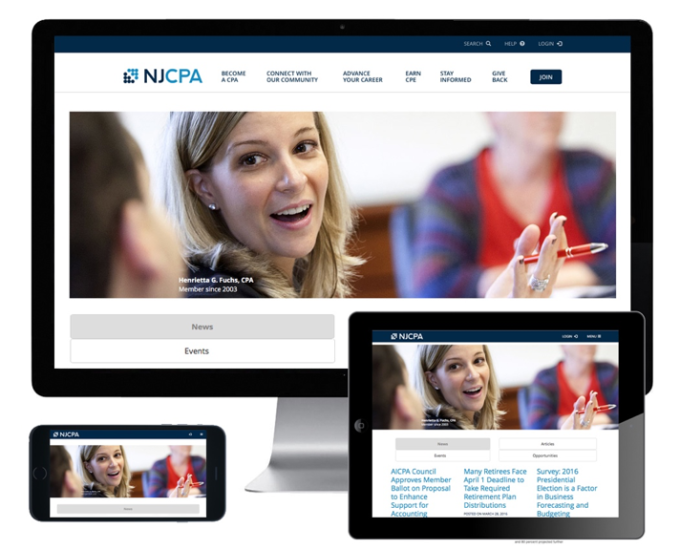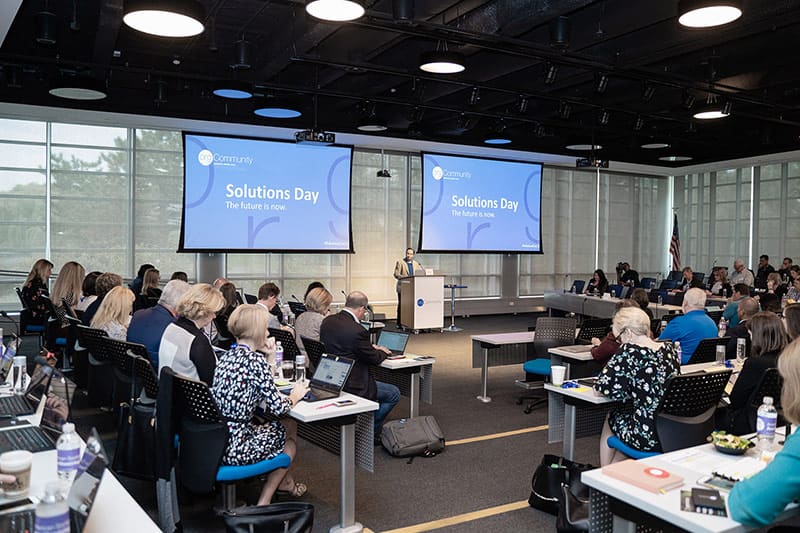Celebrating Associations is a blog produced by .orgCommunity that highlights achievements of associations and the great impact on the industries they serve.
This issue is exclusively sponsored by Results Direct.
Association and History: Founded in 1898, the New Jersey Society of Certified Public Accountants (NJCPA) is the largest professional organization serving the needs of the state’s CPAs and aspiring CPAs. NJCPA offers  more than 500 continuing education programs each year, as well as other networking, leadership and volunteer opportunities. There are 11 chapters and numerous committees and interest groups made up of hundreds of CPA volunteers. NJCPA actively lobbies the state legislature, and promotes the integrity, objectivity, competence and professionalism of CPAs and the quality of their services.
more than 500 continuing education programs each year, as well as other networking, leadership and volunteer opportunities. There are 11 chapters and numerous committees and interest groups made up of hundreds of CPA volunteers. NJCPA actively lobbies the state legislature, and promotes the integrity, objectivity, competence and professionalism of CPAs and the quality of their services.
About Its Members: With a membership of more than 14,000, the NJCPA represents the majority of New Jersey CPAs in public practice, business and industry, government and education.
We’re Celebrating at NJCPA Because: of the impact its new digital strategy is having on operations, culture and customers. What started as a simple need to redesign its website prompted NJCPA to look at its organization more holistically and rethink how it services member needs. To support NJCPA’s transformation, Results Direct provided a comprehensive digital strategy in 2014. The organization has responded by reshaping itself from the inside out.
We’ll Learn More in an Interview with:
- NJCPA Chief Marketing Officer Don Meyer
- NJCPA Brand & Marketing Strategist Heather Weddle
- NJCPA Content & Communications Manager Rachael Bell
- Result Direct’s Senior Solutions Consultant Alex Mouw, CAE
Q: How did NJCPA’s need for a website redesign spark an organizational transformation?
A: (Mouw) Results Direct has had an ongoing partnership with NJCPA. We first started to work together on a redesign project in 2009 (launched in 2010) that focused on information architecture and graphic design. Needs continued to evolve and NJCPA requested help on another redesign in 2013. That design focused more on content strategy and user experience. At the conclusion of that project, a need for a digital strategy was determined and delivered.
(Weddle) We had a number of platforms and systems (website, AMS, CMS, email, marketing automation) that weren’t working in unison to drive transactions or desired outcomes. We were in need of strategic, best-practice guidance to align all these systems and technology to better support our efforts. The website was a snapshot of how we were working as an organization and what we needed to do to work smarter: a better understanding of goals, cross-departmental collaboration, and improved automation. Everyone needed to realize that we’re all on the same team, going after the same goal.
(Meyer) The website is our most publically visible tool. Historically, it had been good at informing, but it needed to transform into a more sales and lead-nurturing implement—driving engagement, exchanges and transactions. We were not nurturing new customers. We had to get people to understand the website is part of a bigger ecosystem of communication platforms. The key was getting buy-in, approval and guidance from upper management—the CEO, COO, CFO and CLO.

Q: What issues does the digital strategy aim to solve?
A: (Mouw) The document is a 10-page executive brief that provides a summary of current challenges and recommendations for short-term and long-term strategies and tactics to address those challenges and organizational goals. The deliverables also included “swim-lanes” to demonstrate the data flow and intersections of information between NJCPA’s key online communications channels (website, email, community, social) and helped them to identify opportunities to better connect systems and information to deliver superior user experiences.
(Meyer) We weren’t evolving because we weren’t getting the 360-degree behavior view of the customer. We needed to change in order to deal with change. Half of our membership is part of the baby boomer generation and retiring within the next 15 years. The number of people taking the CPA exam has flattened. More baby boomers are leaving the profession than the number of millennials entering it. How can we remain relevant to our customer base in this changing environment?
The digital strategy helped us focus on a new approach—a complete departure from how we operated for 10-plus years, from our budgeting to our day-to-day work. It taught us that we constantly need to adjust ourselves to be in tune with what our customers want. We’re now trying to build solutions and experiences based on customer behavior and what they are asking us to do. It’s a new philosophy.
(Weddle) NJCPA has historically been driven by program goals. The former website was an example of that. The problem with that was trying to meet and prioritize everyone’s wants and needs–it was like playing political football. The fact is we are all equally responsible for those programs and successes. The team realized that they would be more effective if the departments could work together.
Q: Describe how the digital strategy has made an impact. What elements of the strategy have been implemented? What have been the results?
A: (Bell) Results Direct introduced the “swim lane” concept to us. It’s about creating paths different users can take so they are not just doing one thing and leaving the site. The purpose is to lead users on a journey by highlighting related items to that visitor. We approached the [most recent] website redesign differently than before—we focused more on the new navigation and structure vs. the [creative]. We had focus groups, scenario-based navigation testing, several iterations of the new navigation—a lot of testing and tweaking. Before the redesign, the website navigation was based on how NJCPA was structured internally instead of being driven by user needs. Now the website is action-oriented and customer-focused. For example, each navigation area is a verb: “Become a CPA,” “Connect With Our Community,” “Advance Your Career,” “Earn CPE,” “Stay Informed,” and “Give Back.”

(Meyer) The strides we’ve made in 18 months is astonishing. Marketing communications didn’t have a strategic seat at the table, and operated more like an order taker for the organization. The digital strategy made the case for marketing, branding, and communications being a part of strategically leading the NJCPA. As a result, the COO approached me with merging membership with the marketing and communications department. Both had the same goal: attract CPAs to join the membership. This was the beginning of breaking down long-standing silos. In January 2016, we also centralized all communication and content functions under Rachael. With this consolidation, we can align the website, magazine and all other communications.
The organization also created several cross-departmental teams that create projects and drive initiatives together. These teams have been able to build alliances, establish trust, and become places for new ideas and suggestions for improvements:
- Senior Executive Committee. Sets and oversees NJCPA’s strategic direction, priorities and policies and reports to the NJCPA Executive Committee. Meets monthly.
- Senior Management Team. Supports and reports to the Senior Executive Committee in the management and execution of operational initiatives and the communication of organizational goals to staff. Meets monthly.
- Program Evaluation Team. Evaluates programs to: a) determine whether resources are effectively allocated to deliver upon the organization’s mission and strategic priorities, b) establish key performance metrics, and c) assesses performance. Reports to the Senior Executive Committee and meets as necessary.
- Risk Management Committee. Oversees the development, implementation and monitoring of loss prevention programs throughout the organization. Reports to the Board of Trustees and meets quarterly.
- Content Steering Team. Supports the development, delivery and promotion of content to drive business leads, influence customer markets and grow the brand. Reports to the Chief Marketing Officer and meets quarterly.
- Information Technology Advisory Team. Proposes IT enhancements to increase staff efficiency and effectiveness, and improve the customer experience. Reports to the COO and meets every other month.
- Disaster Recovery Team. Responsible for maintaining the Disaster Recovery Plan and communicating updates and changes to staff. Reports to the COO and meets annually or as needed.
(Bell) We updated our taxonomy for the first time since 2001, and involved members with this process. The taxonomy is what we use to tag everything—articles, events, videos. Because everything is tagged, we can highlight other articles, events, and resources that match a user’s area of interest. It helps us facilitate those “swim lanes” and get people to move from one thing to the next. We further leverage the taxonomy by offering two fully customized e-newsletters. Each recipient receives content that matches their demographics and areas of interest. The updated taxonomy was what we needed to deliver valuable, personalized content and opportunities.
We also have unified all our platforms creatively—we’ve updated all the fonts and top-level messaging for our emails, newsletters, social media so we can unify the customer experience.
Q: What else is in the works?
A: (Bell) We are in the process of developing a behavioral data warehouse. What members tell us they are interested in and what their behavior shows us they are interested in can be rather different. We are working with Results Direct to merge data from several platforms (website, online community, Google analytics, email marketing and marketing automation tools) to track and collect information to help us do a better job serving members. We are trying to build an infrastructure that will enable customers get to information they want, when and how they want it (blog posts, community discussions, etc.)
We’re really driven today by best practices in the technology space, not the association space. Members are expecting a for-profit online experience (like banking, shopping, ordering food) from their professional associations.
(Weddle) We’ve built a big part of the foundation. The ultimate litmus test will be: Did we meet membership recruitment and retention goals? Our next step is to ensure our technology infrastructure is equipped for us to evolve and to support what our marketplace is asking us to do. Most associations are going to have to rethink their technology “stack”. How are all their technology components connected? Is it doing what they need it to do today, tomorrow—and three years from tomorrow? Do we have what we need to get where we’re going?
Share YOUR Story: What great things is your association doing for its profession or for its operations? How is your organization delivering on its mission and its strategic plan? Contact heather@orgcommunity.com for details about submitting a story or to be interviewed.
Not yet a .orgCommunity member? Invest in yourself and your organization by joining the .orgCommunity, which nurtures innovation in leaders through peer-to-peer interactions and programming.
A Message from Our Sponsor: Results Direct is a leading web and mobile solutions firm based in Alexandria, Va. For more than 20 years,
 Results Direct has guided the nation’s top associations in crafting and implementing online and mobile strategies that have included:
Results Direct has guided the nation’s top associations in crafting and implementing online and mobile strategies that have included:
- Strategic Consulting
- Responsive Design
- Content Management Systems
- Mobile Strategy
- Mobile Apps
- Systems Integration
- Hosting
Results Direct collaborates with more than 100 forward-thinking associations who look to us for innovative and user-focused solutions. Clients include:
- ASAE
- CESSE
- National PTA


